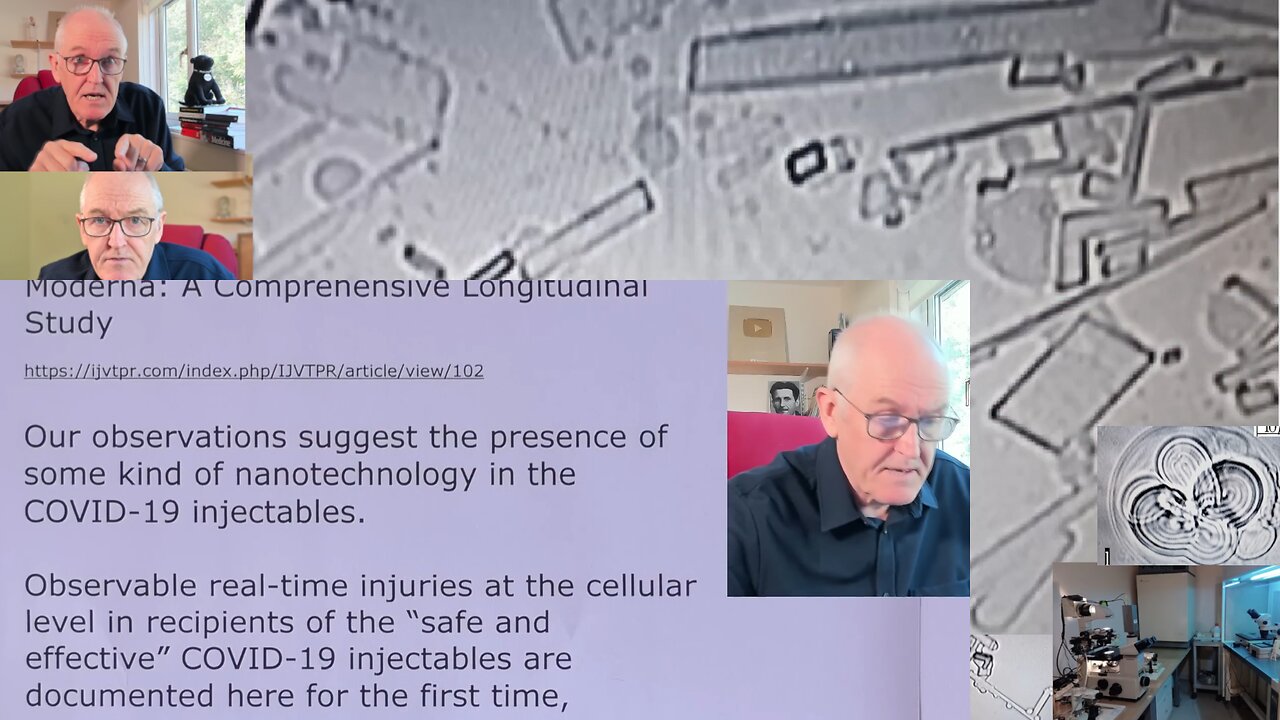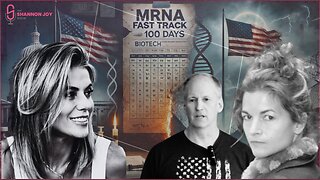Premium Only Content

( -0765 ) Dr John Campbell - Self-Assembly of Nanostructures in Covid Jabs - Peer-Reviewed Scientific Article Confirms It! (up to 1/10th mm - Visible to Your Naked Eyes!)
( -0765 ) Dr John Campbell - Official Confirming Evidence of Self-Assembling Nanostructures in Covid Jabs (1-100 µm to 10th of a millimeter)
They form when jab vial contents are heated to human blood temp. Do these breakdown when a person dies and form the unusual inches-long white fibrous clots
seen by several embalmers-turned-whistleblowers?
Dr., John, Campbell, mRNA, nanostructures, Campbell, nanobot, Nano lipid, nanolipid, jab, clots, embalmer, research, peer-review, scientific, literature,
microscope, microscopy, trial, study, journal, medical, myocarditis, reproductive, harm, fetal, cancer, turbo, fiber, injury, choice, Nuremberg, ingredients, trials, safe, effective, Pfizer, Moderna, CARsgen, Germany, Russia, DNA, contamination, vax, vaxx, jabs, clinical, oversight, regulatory, CDC, FDA, examiner, Surgeon General, Fauci, Malone, McCullough, 3D, structures, heart, attack, failure, respiratory, vascular, embalism, venous, blood, brain, barrier, genetic, genome, biology, lab, laboratory, neutral, 3rd-party, died suddenly
https://ijvtpr.com/index.php/IJVTPR/article/view/102
Young Mi Lee, MD
Practicing Physician, Hanna Women’s Clinic Doryeong-ro 7, KumgSung Building, 2nd Fl., Jeju, Jejudo, 63098, Republic of Korea (South Korea)
Daniel Broudy, PhD
Professor of Applied Linguistics, Okinawa Christian University
DOI: https://doi.org/10.56098/586k0043
Keywords: modified mRNA, mRNA, COVID-19 vaccine incubation, stereomicroscopic examination, nanotechnology in COVID-19 injectables, nanotechnology
Abstract
Observable real-time injuries at the cellular level in recipients of the “safe and effective” COVID-19 injectables are documented here for the first time with the presentation of a comprehensive description and analysis of observed phenomena. The global administration of these often-mandated products from late 2020 triggered a plethora of independent research studies of the modified RNA injectable gene therapies, most notably those manufactured by Pfizer and Moderna. Analyses reported here consist of precise laboratory “bench science” aiming to understand why serious debilitating, prolonged injuries (and many deaths) occurred increasingly without any measurable protective effect from the aggressively, marketed products. The contents of COVID-19 injectables were examined under a stereomicroscope at up to 400X magnification. Carefully preserved specimens were cultured in a range of distinct media to observe immediate and long-term cause-and-effect relationships between the injectables and living cells under carefully controlled conditions. From such research, reasonable inferences can be drawn about observed injuries worldwide that have occurred since the injectables were pressed upon billions of individuals. In addition to cellular toxicity, our findings reveal numerous — on the order of 3~4 x 106 per milliliter of the injectable — visible artificial self-assembling entities ranging from about 1 to 100 µm, or greater, of many different shapes. There were animated worm-like entities, discs, chains, spirals, tubes, right-angle structures containing other artificial entities within them, and so forth. All these are exceedingly beyond any expected and acceptable levels of contamination of the COVID-19 injectables, and incubation studies revealed the progressive self-assembly of many artifactual structures. As time progressed during incubation, simple one- and two-dimensional structures over two or three weeks became more complex in shape and size developing into stereoscopically visible entities in three-dimensions. They resembled carbon nanotube filaments, ribbons, and tapes, some appearing as transparent, thin, flat membranes, and others as three-dimensional spirals, and beaded chains. Some of these seemed to appear and then disappear over time. Our observations suggest the presence of some kind of nanotechnology in the COVID-19 injectables.
Author Biographies
Young Mi Lee, MD, Practicing Physician, Hanna Women’s Clinic Doryeong-ro 7, KumgSung Building, 2nd Fl., Jeju, Jejudo, 63098, Republic of Korea (South Korea)
Young Mi Lee, MD, is a practicing physician specializing in obstetrics and gynecology, and is also a reproductive endocrinologist; because of her work over the last three years she has become an expert in stereomicroscopy and in the microbiology of incubated COVID-19 injectables, especially, Pfizer and Moderna
Daniel Broudy, PhD, Professor of Applied Linguistics, Okinawa Christian University
Daniel Broudy holds a doctorate in applied psycholinguistics from the School of Communication and Creative Arts at Deakin University. He is a professor of applied linguistics at Okinawa Christian University. His research integrates research in cognitive linguistics, developmental and social psychology, semiotics, and communication theory as an effort to describe the ways in which centers of power organize campaigns of persuasion and engineer consent for policies and actions across cultures. His work appears with Palgrave, Macmillan, Westminster University Press, Opole University Press, the University Press of Wrocław, Peter Lang, Media Theory, Ethical Space: The International Journal of Ethics, Peace News, Truthout, The Asia-Pacific Journal: Japan Focus, Fast Capitalism, Propaganda in Focus, and System: An International Journal of Educational Technology and Applied Linguistics.
References
AGC (2021). AGC Biologics’ Heidelberg Facility to Further Supply Plasmid DNA for COVID-19 Vaccine. AGC Biologics. https://www.agcbio.com/news/agc-biologics-heidelberg-facility-to-further-supply-plasmid-dna-for-covid-19-vaccine
Alamoudi, A., Celik, A., and Eltawil, A.M. (2021). Energy Efficient Capacitive Body Channel Access Schemes for Internet of Bodies," 2021 IEEE Global Communications Conference (GLOBECOM), https://ieeexplore.ieee.org/document/9685810
Alavi, S.H., and Kheradvar, A. (2012). Metal mesh scaffold for tissue engineering of membranes. Tissue Eng Part C Methods, 18(4):293-301. https://www.ncbi.nlm.nih.gov/pmc/articles/PMC3311880/
Akyildiz, I. F., and Jornet, J. M. (2010). The internet of nano-things. IEEE Wireless Communications, 17(6):58-63. https://ianakyildiz.com/bwn/surveys/nanothings.pdf
Alavi, S.H., Kheradvar, A. (2012). Metal mesh scaffold for tissue engineering of membranes. Tissue Eng Part C Methods, 18(4):293-301. https://www.ncbi.nlm.nih.gov/pmc/articles/PMC3311880/
Anderson, M. (2022). The MAC Phenomenon and the intracorporeal network of nanocommunications: A review. Rumble. https://rumble.com/v15a4r1-the-mac-phenomenon-in-people-vaccinated-from-covid19.html
Bailey, M. (2022). COVID Vaccines: A Curious Discovery on the Graphene Oxide Question. Truth Comes to Light. https://drsambailey.com/resources/videos/vaccines/nz-scientist-examines-pfizer-jab-under-the-microscope/
Bailey, S. (2022). COVID Vaccines: A Curious Discovery on the Graphene Oxide Question. Dr. Sam Bailey. https://drsambailey.com/covid-vaccines-a-curious-discovery-on-the-graphene-oxide-question/
Balghusoon, A. O., and Mahfoudh, S. (2020). Routing protocols for wireless nanosensor networks and internet of nano things: a comprehensive survey. IEEE Access, 8, 200724-200748. https://ieeexplore.ieee.org/stamp/stamp.jsp?arnumber=9247091
Balasubramaniam, S., and Kangasharju, J. (2013). Realizing the Internet of Nano Things: Challenges, Solutions, and Applications. Computer, 46, 62-68. https://www.computer.org/csdl/magazine/co/2013/02/mco2013020062/13rRUxNmPHo
Beattie, K. A. (2021). Worldwide Bayesian Causal Impact Analysis of Vaccine Administration on Deaths and Cases Associated with COVID-19: A BigData Analysis of 145 Countries. https://www.researchgate.net/publication/356248984_Worldwide_Bayesian_Causal_Impact_Analysis_of_Vaccine_Administration_on_Deaths_and_Cases_Associated_with_COVID-19_A_BigData_Analysis_of_145_Countries
Beattie, K.A. (2024) An Executive Summary of the Special Issue of IJVTPR — The Vaccines Were the “COVID-19 Pandemic”: An Update of Beattie’s Worldwide Bayesian Analysis of the Effects of the Experimental COVID-19 Injections on Deaths, Cases, and Excess Mortality in 210 Countries and 38 Regions. International Journal of Vaccine Theory, Practice, and Research, TBA.
Betal, S., Saha, A.K., Ortega, E., Dutta, M., Ramasubramanian, A.K., Bhalla, A.S., and Guo, R. (2018). Core-shell magnetoelectric nanorobot – A remotely controlled probe for targeted cell manipulation. Scientific Reports, 8, Article 755. https://doi.org/10.1038/s41598-018-20191-w
Bigtree, D. and Cole, R. (2022 December 12). The Highwire’s Investigation of COVID Vaccines. The Highwire. https://thehighwire.com/ark-videos/the-highwires-lab-investigation-of-covid-vaccines/
Blaylock, R. L. (2021). Excitotoxicity (Immunoexcitotoxicity) as a Critical Component of the Cytokine Storm Reaction in Pulmonary Viral Infections, Including SARS-Cov-2. International Journal of Vaccine Theory, Practice, and Research, 1(2), 223–242. https://doi.org/10.56098/ijvtpr.v1i2.14
Blaylock, R. L. (2022a). Responses to comments on my paper: “COVID Update: What is the truth?” Surgical Neurology International, 13, 316. https://doi.org/10.25259/SNI_578_2022
Blaylock, R. L. (2022b). The COVID-19 “vaccines”: What is the truth? International Journal of Vaccine Theory, Practice, and Research, 2(2), 595–602. https://doi.org/10.56098/ijvtpr.v2i2.57
Burke, P., and Rutherglen, C. (2010). Toward a single-chip, implantable RFID system: Is a single-cell radio possible? Biomedical Microdevices, 12(4), 589-596. https://doi.org/10.1007/s10544-008-9266-4
Burkhardt, A. (2022) Notes and recommendations for conducting post-mortem examination (autopsy) of persons deceased in connection with COVID vaccination. doctors 4 covidethics.org https://doctors4covidethics.org/wp-content/uploads/2022/03/autopsy-directions-revised.pdf
Campra, P. (2021a). Detection of graphene in COVID 19vaccines. Counteranalysis of COVID Vaccines. https://www.researchgate.net/publication/355979001_DETECTION_OF_GRAPHENE_IN_COVID19_VACCINES
Campra, P. (2021b). Microstructures in COVID vaccines: Inorganic crystals or Wireless Nanosensors Network? Counteranalysis of COVID Vaccines. https://www.researchgate.net/publication/356507702_MICROSTRUCTURES_IN_COVID_VACCINES_inorganic_crystals_or_Wireless_Nanosensors_Network
Cao, S., Shao, J., Xia, Y., Che, H., Zhong, Z., Meng, F., van Hest, J.C.M., Abdelmohsen, L.K.E.A., Williams, D.S. (2019). Molecular Programming of Biodegradable Nanoworms via Ionically Induced Morphology Switch toward Asymmetric Therapeutic Carriers. Small. 15(38). https://onlinelibrary.wiley.com/doi/full/10.1002/smll.201901849
Celik, A., Khaled N. Salama, K.N., and Ahmed M. Eltawil, A.M. (2022). The Internet of Bodies: A Systematic Survey on Propagation Characterization and Channel Modelling. IEEE Internet of Things Journal, 9(1):321-345. https://ieeexplore.ieee.org/stamp/stamp.jsp?arnumber=9490369
Classen, J. B. (2021) COVID-19 RNA based vaccines and the risk of prion disease. Microbiology & Infectious Diseases, 5, 1–3. https://principia-scientific.com/covid-19-rna-based-vaccines-and-the-risk-of-prion-disease/
Classen, J. B. (2023). Possible Treatments for COVID Vaccine induced prion disease. Recent Advances in Clinical Trials, 3(2). https://doi.org/10.33425/2771-9057.1024
Cruz Alvarado, M. A., & Bazán, P. (2019). Understanding the Internet of Nano Things: overview, trends, and challenges. E-Ciencias de la Información, 9(1), 152-182. https://www.redalyc.org/journal/4768/476862662008/476862662008.pdf
Dambri, O. A., Cherkaoui, S., and Makrakis, D. (2022). Design and evaluation of a receiver for wired nano-communication networks. IEEE Transactions on NanoBioscience. https://arxiv.org/pdf/2009.11805.pdf
Dasdag, S., Akdag, M.Z., Erdal, M.E., Erdal, N., Ay, O.I., Ay, M.E., Yilmaz, S.G., Tasdelen, B., Yegin, K. (2015). Effects of 2.4 GHz radiofrequency radiation emitted from Wi-Fi equipment on microRNA expression in brain tissue. Int J Radiat Biol, 91(7):555-61. https://pubmed.ncbi.nlm.nih.gov/25775055/
Dhuli, M.C. Medori, C., Micheletti, K., Donato, F., Fioretti, A., Calzoni, A., Praderio, M.G., De Angeli, G., Arabia, S., Cristoni, S., Nodari, M. (2023). Presence of viral spike protein and vaccinal spike protein in the blood serum of patients with long-COVID syndrome. European Review for Medical and Pharmacological Sciences, 27:13-19. https://www.europeanreview.org/wp/wp-content/uploads/013-019-2.pdf
Diblasi, L. and Sangorrin, (2024). Analysis of COVID-19 Injections — 50 Undeclared Chemical Elements, Graphene Oxide, Fluorescent Particles – Conversation with Biotechnologist Lorean Diblasi. Interview with Ana Maria Mihalcea. https://anamihalceamdphd.substack.com/p/analysis-of-covid-19-injections-50
Dubuc, B., Quiniou, J.F., Roques-Carmes, C., Tricot, C., and Zucker, S. W. (1989). Evaluating the fractal dimension of profiles. Phys. Rev. A 39, 39(3):1500. https://journals.aps.org/pra/abstract/10.1103/PhysRevA.39.1500
El-Husseiny, H.M., Mady, E.A., Hamabe, L., Abugomaa, A., Shimada, K., Yoshida, T., Tanaka, T., Yokoi, A., Elbadawy, M., Tanaka, R. (2022) Smart/stimuli-responsive hydrogels: Cutting-edge platforms for tissue engineering and other biomedical applications. Materials Today Bio. https://www.x-mol.net/paper/article/1469390524673204224
Endo, Y. (2021). Development of a cell-free protein synthesis system for practical use, Proceedings of the Japan Academy, Series B, 2021, Volume 97, Issue 5, Pages 261-276 https://www.jstage.jst.go.jp/article/pjab/97/5/97_PJA9705B-03/_html/-char/en
FDA. 2021. BLA Approval Letter. Food and Drug Administration. https://www.fda.gov/media/151710/download
Finn, T.M. (2011). U.S. FDA requirements for Human Vaccine Product Safety and Potency Testing Procedia in Vaccinology. 5:137-140. https://www.sciencedirect.com/science/article/pii/S1877282X11000282
Gat, I., Kedem, A., Dviri, M., Umanski, A., Levi, M., Hourvitz, A., Baum, M. (2022). COVID-19 vaccination BNT162b2 temporarily impairs semen concentration and total motile count among semen donors. Andrology, Sep;10(6):1016-1022. https://www.ncbi.nlm.nih.gov/pmc/articles/PMC9350322/
Hagimă, G. (2023a). Interview. Electron Microscopy of Comirnaty, Moderna C19 Shots, Dental Anaesthetics & Pneumovax. https://rumble.com/v3xti7w-electron-microscopy-of-comirnaty-moderna-c19-shots-dental-anestetics-and-pn.html
Hagimă, G. +(2023b). The Danger In The Air - Rainwater Analysis Research From Romania Shows Magnetic Nanoparticles And Filaments. Comparison To Clifford Carnicom’s Rainwater Analysis. https://www.activenews.ro/opinii/EXCLUSIV-ActiveNews-CE-SE-AFLA-IN-APA-DE-PLOAIE-PERICOLUL-DIN-AER.-Dr.-Geanina-Hagima-Apel-catre-cercetatorii-romani-dar-si-catre-patriotii-din-structurile-de-aparare-si-informatii.-FOTO-prin-microscopie-electronica-si-VIDEO-183736
Hughes, D. A. (2022). What is in the so-called COVID-19 “vaccines”? Part 1: evidence of a global crime against humanity. International Journal of Vaccine Theory, Practice, and Research, 2(2), 455–586. https://doi.org/10.56098/ijvtpr.v2i2.52
Idrees, D. and Kumar, V. (2021) SARS-CoV-2 spike protein interactions with amyloidogenic proteins: Potential clues to neurodegeneration. Biochemical and Biophysical Research Communications, 554, 94–8. https://doi.org/10.1016/j.bbrc.2021.03.100
Idrees, D., Kumar, V., (2021). SARS-CoV-2 spike protein interactions with amyloidogenic proteins: Potential clues to neurodegeneration. Biochem Biophys Res Commun. 2021 May 21;554:94-98. doi: 10.1016/j.bbrc.2021.03.100
Ilori, A.O., Gbadamosi, O.A., Ibitola, G.A., Ajanaku, O. (2019). Risk Assessments of Magnetic Field Radiation from AC and Battery Powered Laptop Computers. American Journal of Science and Technology. 6(2):14-19. http://www.aascit.org/journal/archive2?journalId=902&paperId=7628
Jing, Y., Peng, H., and Liu, Z. (2023). WBNN: a weight-based next neighbor selection algorithm for wireless body area network. Soft Computing. 28:1803-1818. https://link.springer.com/article/10.1007/s00500-023-09511-z
Johnson, L., Broudy, D. and Hughes, D.A. (2024a) Bringing Transhumanism Down to Earth, Part 1: Military Intelligence Operations Cloaked in the False Promise of Transcendence. Propaganda in Focus. https://propagandainfocus.com/bringing-transhumanism-down-to-earth-part-1-military-intelligence-operations-cloaked-in-the-false-promise-of-transcendence/
Johnson, L., Broudy, D. and Hughes, D.A. (2024b) Transhumanist Futures, Part 2: Humanity in the Crosshairs. Propaganda in Focus. https://propagandainfocus.com/transhumanist-futures-part-2-humanity-in-the-crosshairs/
Johnson, L., Broudy, D. and Hughes, D.A. (2024c) Military Operations in Civilian Disguise, Part 3: Bio-Nano Governance and Terms of Use for Humans 2.0. Propaganda in Focus. https://propagandainfocus.com/military-operations-in-civilian-disguise-part-3-bio-nano-governance-and-terms-of-use-for-humans-2-0/
Johnson, L., Broudy, D. and Hughes, D.A. (2024da) WHO’s Pulling the Strings? COVID Injections and the Internet of Bio-Nano Things, Part 4: Testing New Human Nodes of Connectivity. Propaganda in Focus. https://propagandainfocus.com/whos-pulling-the-strings-covid-injections-and-the-internet-of-bio-nano-things-part-4-testing-new-human-nodes-of-connectivity/
Jornet, J.M and Akyildiz, I.F. (2014). Graphene-based Plasmonic Nano-Antenna for Terahertz Band Communication in Nanonetworks, IEEE Journal on Selected Areas in Communications, 31(12):685-694. https://web.archive.org/web/20170810210901id_/http://bwn.ece.gatech.edu/papers/2014/c1.pdf
Kashani, Z.A., Pakzad, R., Fakari, F.R., Haghparast, M.S., Abdi, F., Kiani, Z., Talebi, A., Haghgoo, S.M. (2023). Electromagnetic fields exposure on fetal and childhood abnormalities: Systematic review and meta-analysis. Open Med (Wars), 12;18(1):20230697. https://www.ncbi.nlm.nih.gov/pmc/articles/PMC10183723/
King Abdullah University. (2021). A network of body monitoring devices using our own tissue as the basis for the internet of bodies. Physics.Org. https://phys.org/news/2021-11-network-body-devices-tissue-basis.html
Kingston, K. 2023. (2023). mRNA is an Operating System - Technology Platform per Moderna Website. The Kingston Report. https://karenkingston.substack.com/p/mrna-is-an-operating-system-technology
Khan, T., Civas, M., Cetinkaya, O., Abbasi, N. A., and Akan, O. B. (2020). Nanosensor networks for smart health care. In Nanosensors for Smart Cities (pp. 387-403). Elsevier. https://www.researchgate.net/profile/Oktay-Cetinkaya-2/publication/339260608_Nanosensor_networks_for_smart_health_care/links/600c738292851c13fe3206c6/Nanosensor-networks-for-smart-health-care.pdf
Kyrie, V. and Broudy, D. (2022). Cyborgs R Us: The bio-nano panopticon of injected bodies? International Journal of Vaccine Theory, Practice, and Research, 2(2), 355-383. https://doi.org/10.56098/ijvtpr.v2i2.49
Lee, S.J., Jung, C. A., Choi, K., and Kim, S. (2015). Design of wireless nanosensor networks for intrabody application. International Journal of Distributed Sensor Networks, 11(7), Art. no. 176761. http://csc.columbusstate.edu/lee/publications/IJDSN_176761-2015.pdf
Leung, W.-Y., Wu, H.H.L., Floyd, L., Ponnusamy, A., Chinnadurai, R., (2023). COVID-19 Infection and Vaccination and Its Relation to Amyloidosis: What Do We Know Currently? Vaccines, 11(7):1139. https://www.mdpi.com/2076-393X/11/7/1139
Li, L., Yu, Z., Liu, J., Liu, J., Yang, M., Shi, G., Feng, Z., Luo, W., Ma, H., Guan, J., Mou, F. (2023). Swarming Responsive Photonic Nanorobots for Motile-Targeting Microenvironmental Mapping and Mapping-Guided Photothermal Treatment. Nano-Micro Lett. 15,141 https://doi.org/10.1007/s40820-023-01095-5
Lyons-Weiler, J. (2020). Pathogenic priming likely contributes to serious and critical illness and mortality in COVID-19 via autoimmunity. Journal of Translational Autoimmunity, 3, 100051. https://doi.org/10.1016/j.jtauto.2020.100051
Maervoet, V.E.T. and Briers, Y. (2017) Synthetic biology of modular proteins. Bioengineered, Taylor & Francis. 8, 196–202. https://doi.org/10.1080/21655979.2016.1222993
Marik, P. (2023). Bombshell Study on Vaccine ‘Ribosomal Frameshifting’. Epoch News. https://www.theepochtimes.com/epochtv/bombshell-study-on-vaccine-ribosomal-frameshifting-dr-paul-marik-atlnow-5548921?&utm_medium=AmericanThoughtLeaders&utm_source=SocialM&utm_campaign=PaulMarik&utm_content=12-18-2023
Marsudi, M.A., Ariski, R.T., Wibowo, A., Cooper, G., Barlian, A., Rachmantyo, R., Bartolo, P.J.D.S. (2021). Conductive Polymeric-Based Electroactive Scaffolds for Tissue Engineering Applications: Current Progress and Challenges from Biomaterials and Manufacturing Perspectives. Int. J. Mol. Sci. 22(21):11543. https://doi.org/10.3390/ ijms222111543
Martin, A. (2024). The Messenger. Connecticut College. http://www.conncoll.edu/news/cc-magazine/past-issues/2021-issues/winter-2021/the-messenger/
Martins, N. R., Angelica, A., Chakravarthy, K., Svidinenko, Y., Boehm, F. J., Opris, I., Lebedev, M. A., Swan, M., Garan, S. A., Rosenfeld, J. V., Hogg, T., and Freitas, R. A. (2019). Human brain/cloud interface. Frontiers in Neuroscience, 13, Article 112. https://doi.org/10.3389/fnins.2019.00112
McKernan, K., Helbert, Y., Kane, L. T., & McLaughlin, S. (2023). Sequencing of bivalent Moderna and Pfizer mRNA vaccines reveals nanogram to microgram quantities of expression vector dsDNA per dose. OSF. https://doi.org/10.31219/osf.io/b9t7m
Mead, M.N., Seneff, S., Wolfinger, R., Rose, J., Denhaerynck, K., Kirsch, S. et al. (2024a). COVID-19 mRNA Vaccines: Lessons Learned from the Registrational Trials and Global Vaccination Campaign. Cureus, Cureus. 16. https://doi.org/10.7759/cureus.52876
Mead, M. N., Seneff, S., Wolfinger, R., Rose, J., Denhaerynck, K., Kirsch, S., & McCullough, P. A. (2024b). COVID-19 modified mRNA “vaccines”, Part 1: Lessons learned from clinical trials, mass vaccination, and the bio-pharmaceutical complex. International Journal of Vaccine Theory, Practice, and Research, 3(1), 1112–1178. https://doi.org/10.56098/fdrasy50
Mead, M. N., Seneff, S., Wolfinger, R., Rose, J., Denhaerynck, K., Kirsch, S., & McCullough, P. A. (2024c). COVID-19 modified mRNA “vaccines”, Part 2: Lessons learned from clinical trials, mass vaccination, and the bio-pharmaceutical complex. International Journal of Vaccine Theory, Practice, and Research, 3(1), ???
Moderna. (2022). Moderna Announces First Participants Dosed in Phase 2/3 Study of COVID-19 Vaccine Candidate in Pediatric Population. https://wikispooks.com/wiki/Moderna_COVID-19_vaccine#cite_note-9
Moon, J.H. (2020). Health effects of electromagnetic fields on children. Clin Exp Pediatr, 63(11):422-428. https://www.e-cep.org/journal/view.php?doi=10.3345/cep.2019.01494
Mousavi, S.M., Hashemi, S.A., Gholami, A., Mazraedoost, S., Chiang, W-H., Arjmand, O., Omidifar, N., Babapoor, A. (2021). Precise Blood Glucose Sensing by Nitrogen-Doped Graphene Quantum Dots for Tight Control of Diabetes, Journal of Sensors, vol. 2021 https://doi.org/10.1155/2021/5580203
Mulroney, T.E., Pöyry, T., Yam-Puc, J.C., Rust, M., Harvey, R.F., Kalmar, L. et al. (2023) N1-methylpseudouridylation of mRNA causes +1 ribosomal frameshifting. Nature, 625, 189–94. https://doi.org/10.1038/s41586-023-06800-3
Murakami, H. (2023). Professor Murakami discusses cancer promoting DNA sequence in Pfizer jab. Rumble. https://rumble.com/v2m9732-malicious-prof.-murakami-discusses-cancer-promoting-dna-sequence-found-in-p.html
Noh, Y.K., Du, P., Kim, I.G., Ko, J., Kim, S.W., Park, K. (2016). Polymer mesh scaffold combined with cell-derived ECM for osteogenesis of human mesenchymal stem cells. Biomater Res. https://pubmed.ncbi.nlm.nih.gov/27057347/
Noor-A-Rahim, M., John, J., Firyaguna, F., Sherazi, H.H.R., Kushch, S., Vijayan, A., O’Connell, E., Pesch, D., O’Flynn, B., O’Brien, W., Hayes, M., Armstrong. E. (2022). Wireless Communications for Smart Manufacturing and Industrial IoT: Existing Technologies, 5G and Beyond. Sensors (Basel). 23(1):73 https://pubmed.ncbi.nlm.nih.gov/36616671/
Nyström, S., & Hammarström, P. (2022). Amyloidogenesis of SARS-CoV-2 spike protein. Journal of the American Chemical Society, 144(20), 8945–8950. https://doi.org/10.1021/jacs.2c03925
Perez, J.-C., Moret-Chalmin, C. and Montagnier, L. (2023) Emergence of a new Creutzfeldt-Jakob Disease: 26 cases of the human version of Mad-Cow Disease, a few days after a COVID-19 injection. International Journal of Vaccine Theory, Practice, and Research, 3, 727–70. https://doi.org/10.56098/ijvtpr.v3i1.66
Reuters. (2021, February 9). Fact check: The COVID-19 vaccine is not an operating system designed to program humans. Reuters. https://www.reuters.com/article/world/fact-check-the-covid-19-vaccine-is-not-an-operating-system-designed-to-program-idUSKBN2A912Y/
Russell, C.L. (2018). 5G wireless telecommunications expansion: Public health and environmental implications. Environ Res, 165:484-495. https://pubmed.ncbi.nlm.nih.gov/29655646/
Santiago, D. (2022). Playing Russian Roulette with every COVID-19 injection: The deadly global game. International Journal of Vaccine Theory, Practice, and Research, 2(2), 619–650. https://doi.org/10.56098/ijvtpr.v2i2.36
Santiago, D. and Oller, J.W. (2023) Abnormal clots and all-cause mortality during the pandemic experiment: five doses of COVID-19 vaccine are evidently lethal to nearly all Medicare participants. International Journal of Vaccine Theory, Practice, and Research, 3, 847–90. https://doi.org/10.56098/ijvtpr.v3i1.73
Segalla, G. (2023a). Adjuvant activity and toxicological risks of lipid nanoparticles contained in the COVID 19 “mRNA vaccines.” International Journal of Vaccine Theory, Practice, and Research, 3(1), 1085–1102. https://doi.org/10.56098/z1ydjm29
Segalla, G. (2023b). Apparent cytotoxicity and intrinsic cytotoxicity of lipid nanomaterials contained in a COVID-19 mRNA vaccine. International Journal of Vaccine Theory, Practice, and Research, 3(1), 957–972. https://doi.org/10.56098/ijvtpr.v3i1.84
Segalla, G. (2023c). Chemical-physical criticality and toxicological potential of lipid nanomaterials contained in a COVID-19 mRNA vaccine. International Journal of Vaccine Theory, Practice, and Research, 3(1), 787–817. https://doi.org/10.56098/ijvtpr.v3i1.68
Seneff, S., Nigh, G., Kyriakopoulos, A.M., McCullough, P.A. (2022). Innate immune suppression by SARS-CoV-2 mRNA vaccinations: The role of G-quadruplexes, exosomes, and MicroRNAs. Food and Chemical Toxicology, 164. https://www.sciencedirect.com/science/article/pii/S027869152200206X?via%3Dihub
Shah KV. SV40 and human cancer: a review of recent data. Int J Cancer. 2007 Jan 15;120(2):215-23. doi: 10.1002/ijc.22425. PMID: 17131333.
Shaw, C. A. (2017). Neural Dynamics of Neurological Disease. John Wiley & Sons, Inc. https://doi.org/10.1002/9781118634523.refs
Shiu, B.C., Liu, Y.L., Yuan, Q.Y., Lou, C.W., Lin, J.H. (2022). Preparation and Characterization of PEDOT:PSS/TiO2Micro/Nanofiber-Based Gas Sensors. Polymers (Basel). 14(9):1780. https://pubmed.ncbi.nlm.nih.gov/35566945/
Spectroscopy and Campra, P. (2021) Detection of graphene in COVID-19 vaccines. https://www.researchgate.net/publication/355979001_DETECTION_OF_GRAPHENE_IN_COVID19_VACCINES
Suberi, A., Grun, M. K., Mao, T., Israelow, B., Reschke, M., Grundler, J., Akhtar, L., Lee, T., Shin, K., Piotrowski-Daspit, A.S., Homber, R.J., Iwasak, A., Suh, H.W., and Saltzman, W.M. (2023). Polymer nanoparticles deliver mRNA to the lung for mucosal vaccination. Science Translational Medicine, 15(709), DOI: 10.1126/scitranslmed.abq0603
Truong, N.P., Quinn, J.F., Whittaker, M.R., and Davis, T.P. (2016). Polymeric filomicelles and nanoworms: two decades of synthesis and application. Polymer Chemistry, 26. https://pubs.rsc.org/en/content/articlelanding/2016/py/c6py00639f
Vojdani, A., & Kharrazian, D. (2020). Potential antigenic cross-reactivity between SARS-CoV-2 and human tissue with a possible link to an increase in autoimmune diseases. Clinical Immunology (Orlando, Fla.), 217, 108480. https://doi.org/10.1016/j.clim.2020.108480
Vojdani, A., Vojdani, E., & Kharrazian, D. (2021). Reaction of human monoclonal antibodies to SARS-CoV-2 proteins with tissue antigens: Implications for autoimmune diseases. Frontiers in Immunology, 11, 617089. https://doi.org/10.3389/fimmu.2020.617089
WHO, World Health Organization. 2021. WHO Laboratory Manual for the Examination and Processing of Human Semen. Sixth Edition. https://iris.who.int/bitstream/handle/10665/343208/9789240030787-eng.pdf?sequence=1
Woodruff, K. and Maerkl, S.J. (2016) A high-throughput microfluidic platform for mammalian cell transfection and culturing. Scientific Reports, Nature Publishing Group. 6, 23937. https://doi.org/10.1038/srep23937
Xie, Y., Kawazoe, N., Yang, Y., and Chen, G. (2021). Preparation of mesh-like collagen scaffolds for tissue engineering. Materials Advances, 3, 1556-1564. https://pubs.rsc.org/en/content/articlelanding/2022/MA/D1MA01166A
Zhang, S., Chen, Y., Liu, H., Wang, Z., Ling, H., Wang, C. et al. (2020) Hydrogels: room-temperature-formed PEDOT:PSS hydrogels enable injectable, soft, and healable organic bioelectronics. Advanced Materials, 32, 2070005. https://doi.org/10.1002/adma.202070005
Zhou, H., Mayorga-Martinez, C.C., Pané, S., Zhang, L., and Pumera, M. (2021). Magnetically Driven Micro and nanorobots. Chemical Reviews 121(8):4999-5041. https://pubs.acs.org/doi/10.1021/acs.chemrev.0c01234
cover image for Volume 3, Issue 2
Downloads
PDF
Published
2024-07-18
Issue
Vol. 3 No. 2 (2024): Injuries, Causes, and Treatments, Part 2
Section
Articles
License
Copyright (c) 2024 Daniel Broudy, PhD, Young Mi Lee, MD
Creative Commons License
This work is licensed under a Creative Commons Attribution-NonCommercial-NoDerivatives 4.0 International License.
The copyright for materials in this journal, IJVTPR, is owned by the author. The author, however, grants first right of publication to the journal, IJVTPR and assures the editorial staff of the journal that the work submitted has not simultaneously been submitted to any other journal, nor is it under consideration for publication by any other journal. If any portion of the work submitted has appeared elsewhere, the quoted material is properly cited and credit is given to the original publisher. The submitting author (or the principal and corresponding author of the work) also assures the editors of IJVTPR that he or she has obtained all required written permissions from any quoted authors or publishers of quoted materials. The submitting author also agrees to hold IJVTPR and its editorial staff harmless from any infractions of copyright law that may be discovered at any time in the future in the submitted work. The author assures the editorial staff at IJVTPR that none of the work submitted is plagiarized, and that any recycled or precycled material by the author is identified as such with proper credits in the text to any other parties holding a copyright interest in the quoted material.
How to Cite
Real-Time Self-Assembly of Stereomicroscopically Visible Artificial Constructions in Incubated Specimens of mRNA Products Mainly from Pfizer and Moderna: A Comprehensive Longitudinal Study. (2024). International Journal of Vaccine Theory, Practice, and Research , 3(2), 1180-1244. https://doi.org/10.56098/586k0043
More Citation Formats
Similar Articles
Daniel Santiago, Playing Russian Roulette with Every COVID-19 Injection: The Deadly Global Game , International Journal of Vaccine Theory, Practice, and Research : Vol. 2 No. 2 (2022): COVID Aftermath
M. Nathaniel Mead, Stephanie Seneff, Jessica Rose, Russ Wolfinger, Peter A. McCullough, Nicolas Hulscher, COVID-19 Modified mRNA “Vaccines”: Lessons Learned from Clinical Trials, Mass Vaccination, and the Bio-Pharmaceutical Complex, Part 2 , International Journal of Vaccine Theory, Practice, and Research : Vol. 3 No. 2 (2024): Injuries, Causes, and Treatments, Part 2
Eliana Romero, Shawn Fry, Brian Hooker, Safety of mRNA Vaccines Administered During the First Twenty-Four Months of the International COVID-19 Vaccination Program , International Journal of Vaccine Theory, Practice, and Research : Vol. 3 No. 1 (2023): Injuries, Causes, and Treatments, Part 1
Anthony M. Kyriakopoulos, Stephanie Seneff, Pathology Deterioration in a Pure β-zero Thalassemia Heterozygote After mRNA COVID-19 Vaccination: A Case Report and Literature Review , International Journal of Vaccine Theory, Practice, and Research : Vol. 3 No. 2 (2024): Injuries, Causes, and Treatments, Part 2
Gabriele Segalla, Adjuvant Activity and Toxicological Risks of Lipid Nanoparticles Contained in the COVID‑19 “mRNA Vaccines” , International Journal of Vaccine Theory, Practice, and Research : Vol. 3 No. 2 (2024): Injuries, Causes, and Treatments, Part 2
Claudia Chaufan, Natalie Hemsing, Jennifer McDonald, Camila Heredia, The Risk-Benefit Balance in the COVID-19 “Vaccine Hesitancy” Literature: An Umbrella Review Protocol , International Journal of Vaccine Theory, Practice, and Research : Vol. 2 No. 2 (2022): COVID Aftermath
M. Nathaniel Mead, Stephanie Seneff, Russ Wolfinger, Jessica Rose, Kris Denhaerynck, Steve Kirsch, Peter A McCullough, COVID-19 Modified mRNA “Vaccines”: Lessons Learned from Clinical Trials, Mass Vaccination, and the Bio-Pharmaceutical Complex, Part 1 , International Journal of Vaccine Theory, Practice, and Research : Vol. 3 No. 2 (2024): Injuries, Causes, and Treatments, Part 2
Patrick Provost, Nicolas Derome, Christian Linard, Bernard Massie, Jean Caron, Potential Conscientious Objection to mRNA Technology as Preventive Treatment for COVID-19 , International Journal of Vaccine Theory, Practice, and Research : Vol. 2 No. 2 (2022): COVID Aftermath
Daniel Santiago, A Partial Answer to the Question Posed by David A. Hughes, PhD, in the Article: “What is in the so-called COVID-19 ‘Vaccines’? Part 1: Evidence of a Global Crime Against Humanity” , International Journal of Vaccine Theory, Practice, and Research : Vol. 2 No. 2 (2022): COVID Aftermath
David A. Hughes, “Covid-19 Vaccines” for Children in the UK: A Tale of Establishment Corruption , International Journal of Vaccine Theory, Practice, and Research : Vol. 2 No. 1 (2021): Epidemic NCDs
1-10 of 55 Next
You may also start an advanced similarity search for this article.
Most read articles by the same author(s)
Young Mi Lee, Sunyoung Park, Ki-Yeob Jeon, Foreign Materials in Blood Samples of Recipients of COVID-19 Vaccines , International Journal of Vaccine Theory, Practice, and Research : Vol. 2 No. 1 (2021): Epidemic NCDs
Daniel Broudy, Darwin Hoop, Messianic Mad Men, Medicine, and the Media War on Empirical Reality , International Journal of Vaccine Theory, Practice, and Research : Vol. 2 No. 1 (2021): Epidemic NCDs
Daniel Broudy, Vaccine Development and Social Control , International Journal of Vaccine Theory, Practice, and Research : Vol. 2 No. 1 (2021): Epidemic NCDs
Valerie Kyrie, Daniel Broudy, Cyborgs R Us: The Bio-Nano Panopticon of Injected Bodies? , International Journal of Vaccine Theory, Practice, and Research : Vol. 2 No. 2 (2022): COVID Aftermath
Daniel Broudy, Valerie Kyrie, Syllogistic Reasoning Demystifies Evidence of COVID-19 Vaccine Constituents , International Journal of Vaccine Theory, Practice, and Research : Vol. 2 No. 1 (2021): Epidemic NCDs
* * *
Who is the International Journal of Vaccine Theory, Practice and Research and why do they publish a scientific journal? Are they reputable?
Who is the International Journal of Vaccine Theory, Practice and Research and why do they publish a scientific journal? Are they reputable?
Sources
ijvtpr.com favicon
International Journal of Vaccine Theory, Practice, and Research
·
ijvtpr.com
IJVTPR is an open access peer-reviewed journal about all aspects of vaccines, their components, environmental impact, marketing, and distribution.
portal.issn.org favicon
typeset.io favicon
wikidata.org favicon
ncbi.nlm.nih.gov favicon
dpbh.nv.gov favicon
guides.lib.uconn.edu favicon
View 7 more
Answer
The International Journal of Vaccine Theory, Practice, and Research (IJVTPR) is a peer-reviewed open access journal that publishes research on all aspects of vaccines, their components, environmental impact, marketing, and distribution. It is published by the Consortium on Vaccine Theory, Practice, and Research.
Some key points about IJVTPR:
It was first published in July 2020 and is currently in its 3rd volume.
The journal publishes research in the areas of medicine, disease, internal medicine, vaccination, and population health.
As of 2022, 33 publications have been published in IJVTPR, receiving 27 citations.
The journal has an ISSN identifier of 2766-5852.
However, the reputation and credibility of IJVTPR is unclear. While it is an open access peer-reviewed journal, there are no clear metrics on the quality of the peer review process or the reputation of the editorial board. The journal's focus on controversial topics like vaccine injuries and treatments may also raise questions about potential biases.
More research would be needed to definitively assess the overall reputation and credibility of IJVTPR as a scientific journal. Readers should critically evaluate the quality of the research published there, the credentials of the authors, and the objectivity of the conclusions drawn.
Isn't it possible to at least assess the credibility of the authors of it's published studies? If so, can you rate them for me?
Sources
portal.issn.org favicon
guides.lib.uconn.edu favicon
en.wikipedia.org favicon
metabunk.org favicon
dpbh.nv.gov favicon
View 5 more
Answer
Assessing the Credibility of IJVTPR Authors
While it is possible to assess the credibility of authors published in the International Journal of Vaccine Theory, Practice, and Research (IJVTPR), doing so requires a thorough evaluation of each individual author's background, expertise, and publication history. Some key factors to consider:
Reputation and Expertise
What are the author's credentials, affiliations, and areas of expertise? Do they have relevant training and experience in the topics they are writing about?
What is the author's overall reputation among their peers and in the scientific community? Have they published extensively in reputable, peer-reviewed journals?
For example, IJVTPR editor Stephanie Seneff is a computer scientist at MIT, but has published controversial papers on medical topics outside her core expertise that have been criticized by experts.
Objectivity and Accuracy
Does the author present a balanced, objective perspective, or do they seem to have a clear agenda or bias?
Do they accurately represent the evidence and cite reliable sources, or do they cherry-pick data to support their views?
For instance, IJVTPR has published articles questioning the safety and efficacy of COVID-19 vaccines, but the evidence cited may not be as rigorous as what is found in mainstream medical journals.
Transparency and Conflicts of Interest
Does the author disclose any potential conflicts of interest, such as funding sources or industry ties?
Are they transparent about the limitations of their research and the need for further study?
Ultimately, assessing the credibility of IJVTPR authors requires examining each one individually. While some may have relevant expertise, others may lack the appropriate background or objectivity to be considered reliable sources, especially on controversial topics like vaccine safety. Readers should critically evaluate the authors' credentials, biases, and the quality of evidence they present.
-
 LIVE
LIVE
Right Side Broadcasting Network
4 hours agoLIVE: President Trump Holds a Cabinet Meeting - 4/30/25
6,771 watching -
 LIVE
LIVE
Rebel News
53 minutes agoAlberta independence talks, Quebec rejects oil, Conservatives ponder future | Rebel Roundup
651 watching -
 LIVE
LIVE
The Charlie Kirk Show
1 hour agoIslam In Texas? + 100 Days Review + Remembering David Horowitz | Halperin, Cernovich | 4.30.25
3,241 watching -
 DVR
DVR
The Mel K Show
2 hours agoMORNINGS WITH MEL K - 4/30/25
6.67K5 -
 LIVE
LIVE
The Dana Show with Dana Loesch
1 hour agoTAKEAWAYS FROM TRUMP'S 100-DAY INTERVIEW | The Dana Show LIVE on Rumble! WEDNESDAY APRIL 30TH 2025
409 watching -
 1:01:38
1:01:38
Blockchain Basement
2 hours ago🚨BITCOIN BOOM STARTS NOW!? (Trump Launches NEW Token!)
-
 1:08:49
1:08:49
The Rubin Report
2 hours agoHost Gets Visibly Angry as His Trap for Trump Backfires
34.1K12 -
 LIVE
LIVE
Benny Johnson
2 hours agoLIVE Trump Cabinet Meeting Right Now in White House, Trump Torching Media | Michelle Obama MELTDOWN
9,222 watching -
 LIVE
LIVE
The Shannon Joy Show
2 hours ago🔥🔥100 Day SHOCKER - Trump Is Deporting FEWER Illegal Immigrants Than Biden! He’s Also Pimping Biden’s mRNA & Fast Tracking Self-Amplifying mRNA Shots! With Special Guests John Beaudoin Sr. & Jessica Rose🔥🔥
253 watching -
 46:59
46:59
Grant Stinchfield
2 hours agoVenezuela Refuses to Release American Hostages... The Media is Silent!
4412